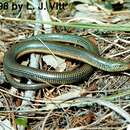en
names in breadcrumbs


The eastern glass lizard (Ophisaurus ventralis) is a species of legless lizard in the family Anguidae, endemic to the Southeastern United States. The streamlined, legless species is often confused with snakes. Glass Lizards differ from snakes as they possess a moveable eyelid and an external ear opening, both of which are absent in snakes. Ventralis comes from the Latin "venter" meaning belly; this is in reference to the snake-like movement. [5]
Adults of O. ventralis grow to 46–108 cm (18–43 in) in total length, although the head-body length is only 30.5 cm (12.0 in) at most. There are 99 or more scales along the lateral groove. In this species, no dark longitudinal stripes are present below the lateral groove or under the tail, and there is no distinct mid-dorsal stripe. The neck is marked with a series of mostly vertical, or highly irregular, white marks, with white markings on posterior corners of scales. Palatine teeth are present.[6] Dorsally, older specimens have a pattern consisting of numerous longitudinal dark lines or dashes. Occasionally, similar parallel lines cover the entire mid-dorsal area. Older adults may be greenish above and yellow below; this is the only Ophisaurus species that may have a greenish appearance. Juveniles are khaki-colored and usually have two dark stripes that run down the back.[7] O. ventralis are commonly mistaken as a species of snake because they lack limbs. Unlike snakes, they have moveable eyelids, external ear openings located behind their eyes, and inflexible jaws. [8] The three extant species of Ophisaurus that live in North America can be distinguished by their differences in number of teeth and sizes of skulls from skeletal analysis.[9]
No subspecies are currently recognized.[2]
Eastern glass lizards are a common species near wetlands and moist soils.[10] O. ventralis habitat consists of flatwoods adjacent to wetlands with sandy soils. They heavily rely on prescribed fire to maintain their habitat. [11] They have also been found in tidal areas such as coastal dunes because they are resistant to salty conditions.[12] Eastern glass lizards are most active during the day and can be found foraging in open habitats but also like to take refuge beneath debris.[13]
A study in 2020 found O. ventralis using a crayfish burrow as habitat in southeastern Mississippi. Various invertebrates and vertebrates are known to use these burrows but this is the first time a lizard species has been documented using a crayfish burrow. Limited research has been done but could be more widespread behavior.[14] Direct mortality due to prescribed fire is of concern to land managers using fire as a management tool in the eastern glass lizard's habitat. [15]
O. ventralis is commonly found from extreme southeastern Virginia to south Florida and west to Louisiana. They are restricted to the coastal plains of the southeastern United States, and populations are restricted by the Mississippi River.[16][17] Isolated records exist of its occurrence in Oklahoma and Missouri.[7]
O. ventralis eats a range of insects, such as grasshoppers, crickets and beetles, and will also consume spiders, small mice, snails, and the eggs of other reptiles and ground-nesting birds. Unlike snakes, glass lizards do not have flexible jaws, and this limits the size of prey items they can consume. They forage both above ground and underground in burrows.[18]
Common predators of the eastern glass lizard include skunks, raccoons, foxes, snakes, and cats. They have the ability of tail autotomy, meaning their tail breaks off upon restraint. Their tail fragment will continue to writhe for several minutes after detachment to distract the predator and allow them to escape. [19]
O. ventralis is oviparous and lays around 5–15 eggs in June and July. Eggs are usually laid under cover or in depressions and sandy or loamy soil. Females will encircle their clutch but may retreat when approached and generally do not defend their eggs. [20]
The eastern glass lizard (Ophisaurus ventralis) is a species of legless lizard in the family Anguidae, endemic to the Southeastern United States. The streamlined, legless species is often confused with snakes. Glass Lizards differ from snakes as they possess a moveable eyelid and an external ear opening, both of which are absent in snakes. Ventralis comes from the Latin "venter" meaning belly; this is in reference to the snake-like movement.